How to teach words and expressions
文档属性
| 名称 | How to teach words and expressions |  | |
| 格式 | rar | ||
| 文件大小 | 9.3MB | ||
| 资源类型 | 教案 | ||
| 版本资源 | 牛津译林版 | ||
| 科目 | 英语 | ||
| 更新时间 | 2020-07-22 09:43:36 | ||
图片预览


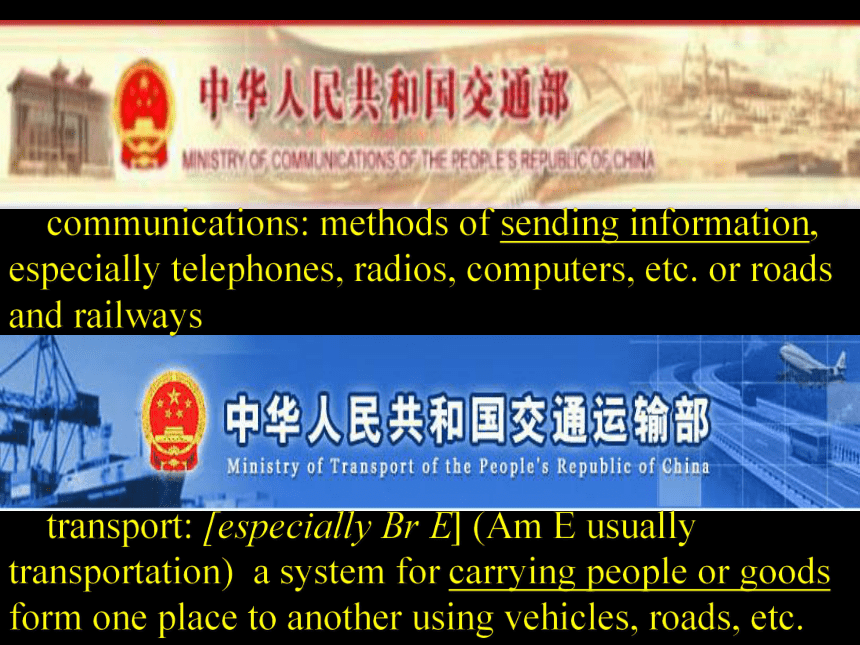

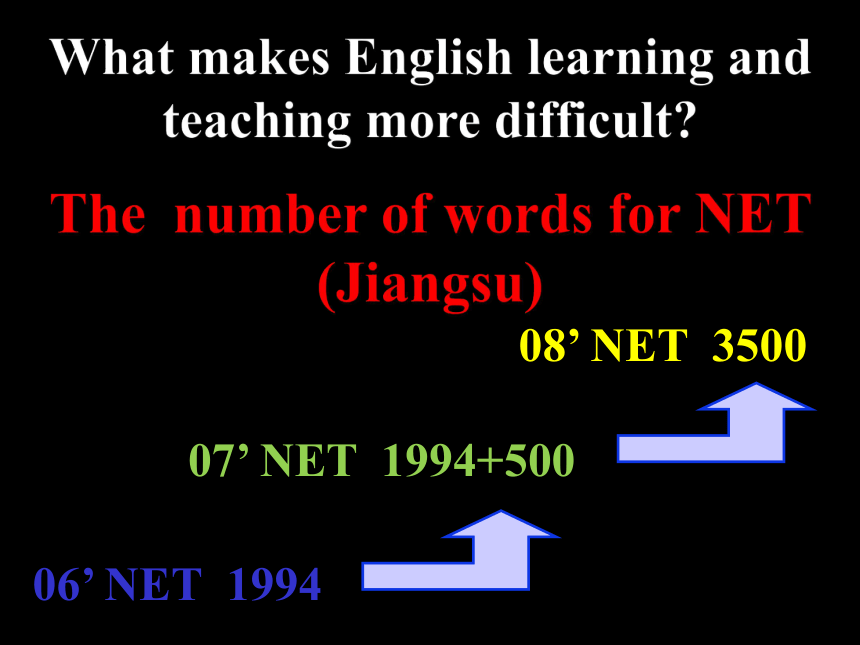
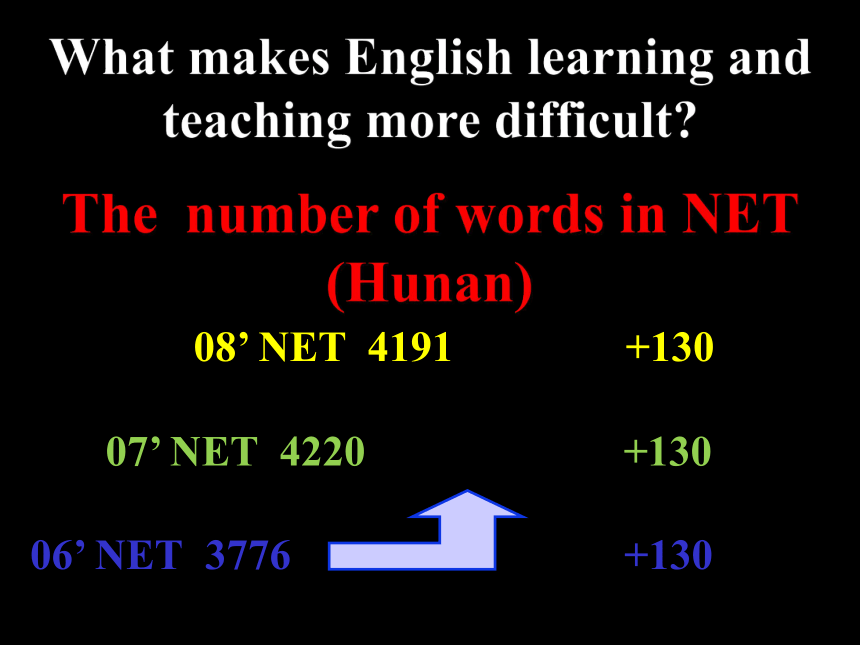
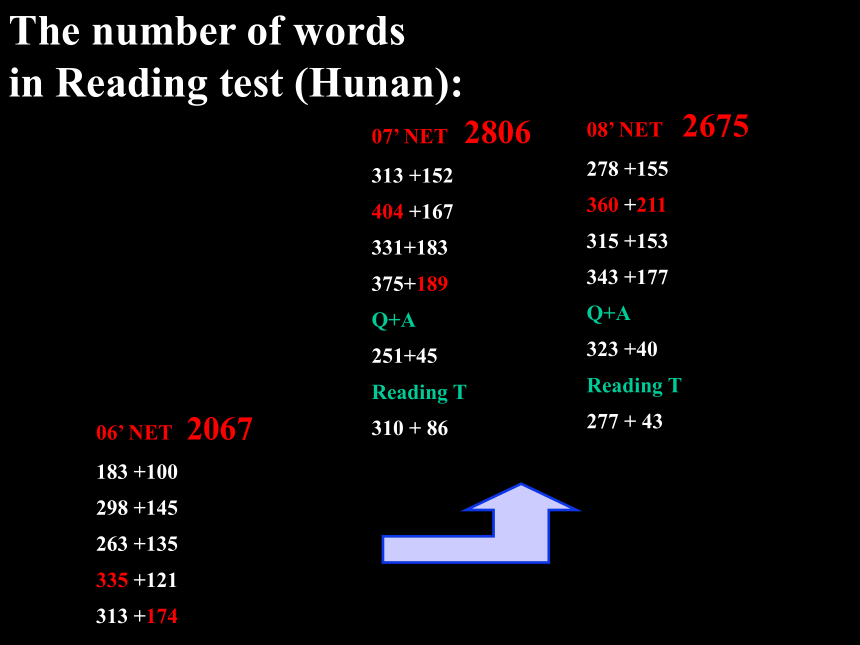
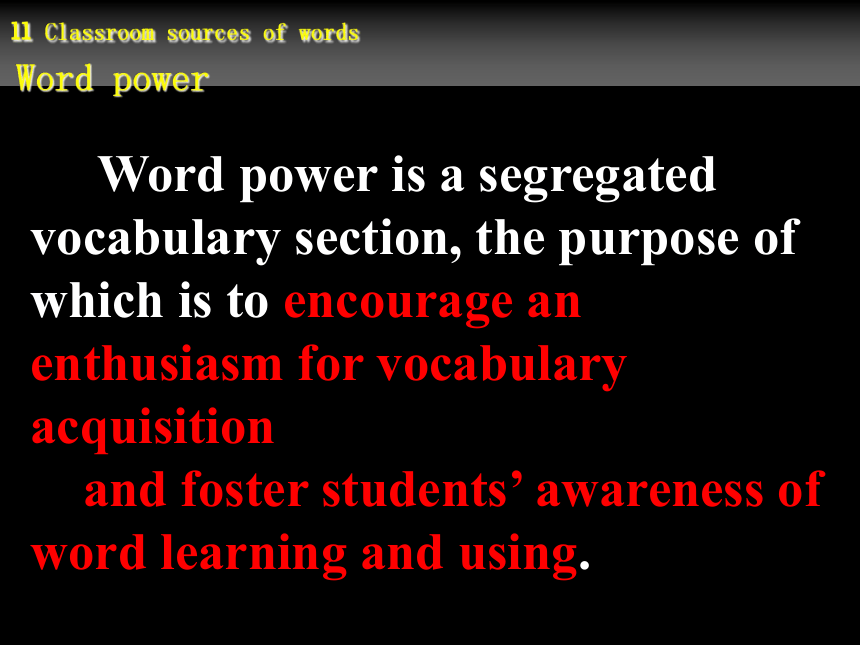
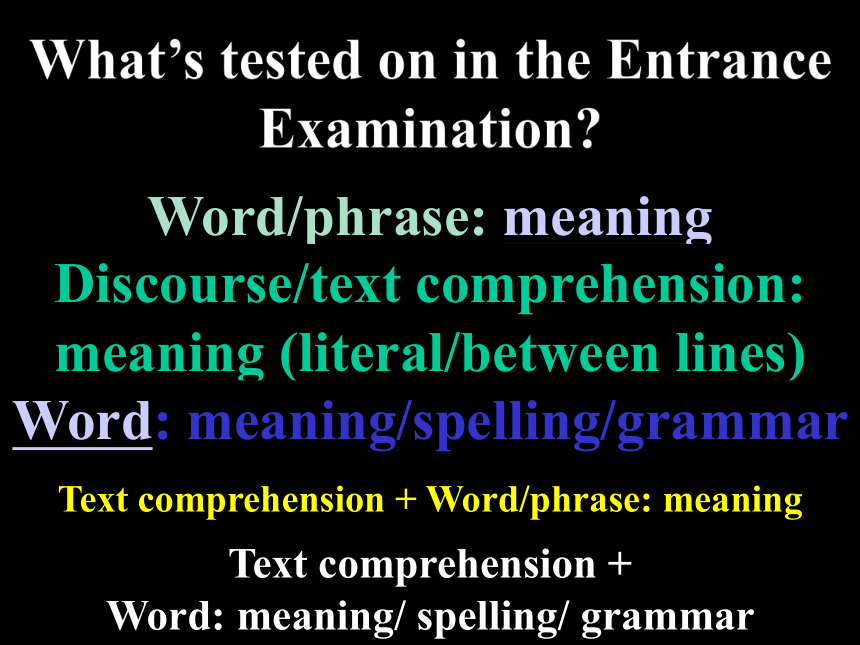
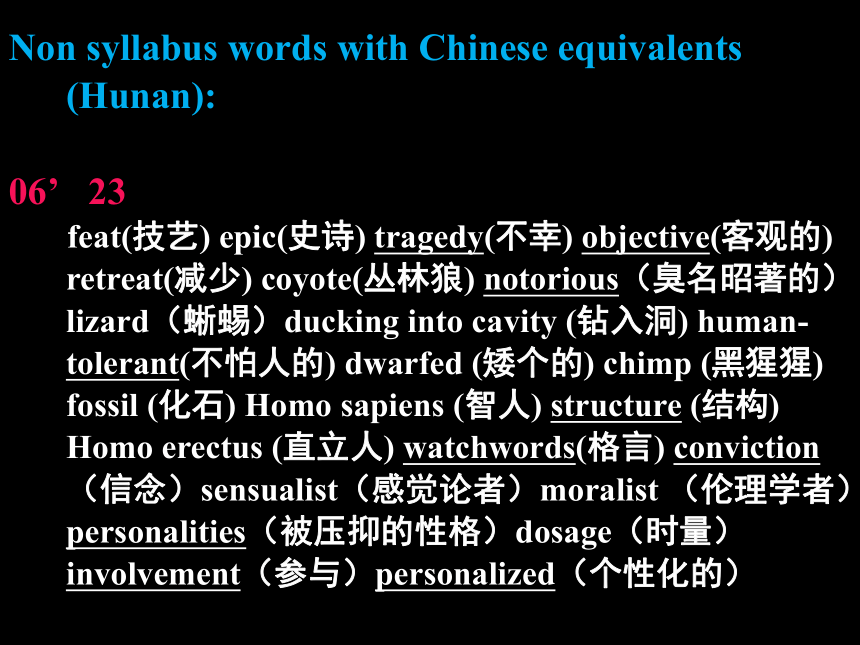
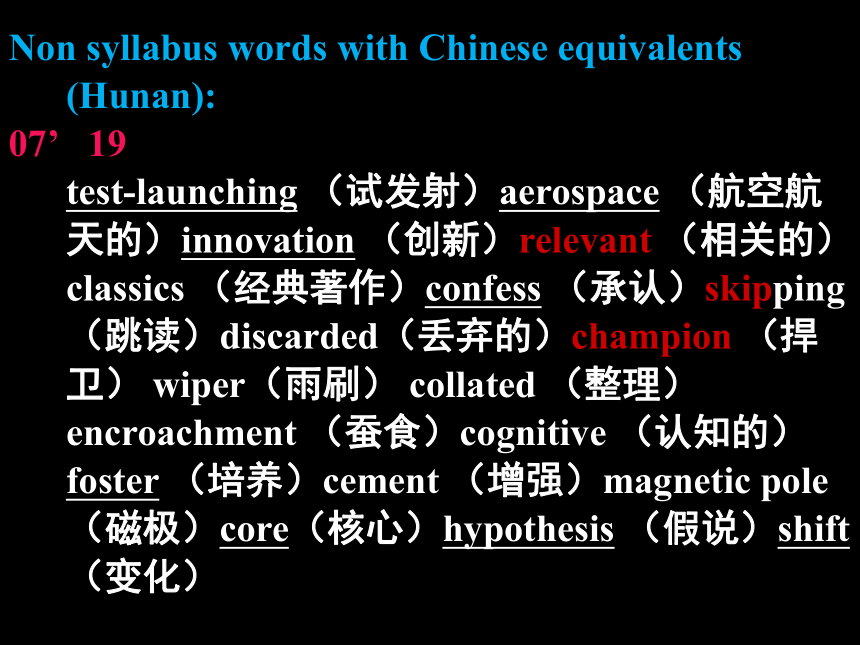
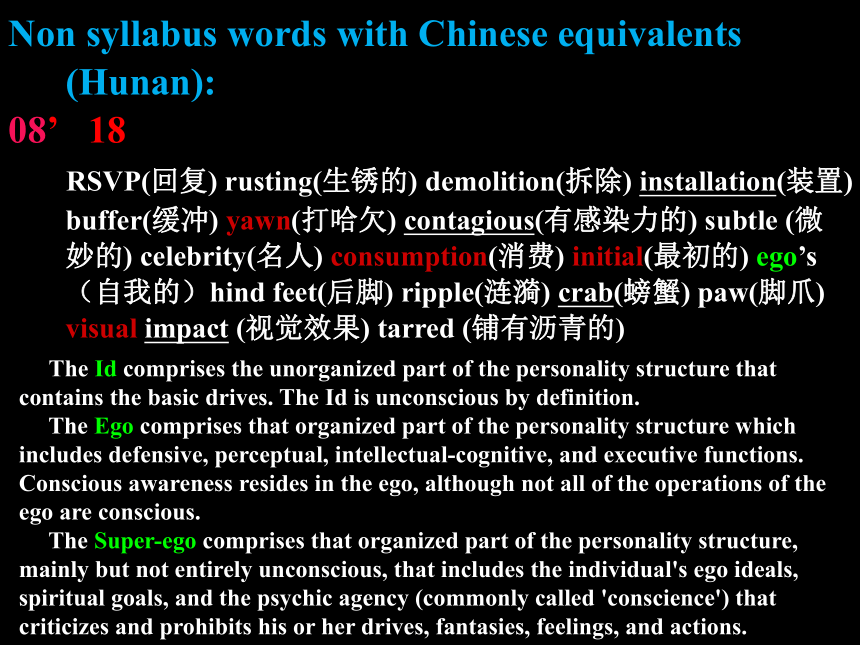
文档简介
课件56张PPT。
How to teach words and expressions
--- Coping with Word PowerYe Ningqing “Without grammar very little can be conveyed, without vocabulary nothing can be conveyed.”
David WilkinsThe importance of vocabulary building
What’s the English for?
中华人民共和国交通部 communications: methods of sending information, especially telephones, radios, computers, etc. or roads and railways transport: [especially Br E] (Am E usually transportation) a system for carrying people or goods form one place to another using vehicles, roads, etc. Please flush after use.handily: in a way that is convenient; easily
What makes English learning and teaching more difficult?
What makes English learning and teaching more difficult?
06’ NET 2067
183 +100
298 +145
263 +135
335 +121
313 +17407’ NET 2806
313 +152
404 +167
331+183
375+189
Q+A
251+45
Reading T
310 + 8608’ NET 2675
278 +155
360 +211
315 +153
343 +177
Q+A
323 +40
Reading T
277 + 43 Ⅱ Classroom sources of words Word power Word power is a segregated vocabulary section, the purpose of which is to encourage an enthusiasm for vocabulary acquisition
and foster students’ awareness of word learning and using. Multiple choice
Listening
Reading
Writing
Cloze
Gap fill
What’s tested on in the Entrance Examination?Word/phrase: meaningDiscourse/text comprehension: meaning (literal/between lines)Word: meaning/spelling/grammar Text comprehension + Word/phrase: meaningText comprehension +
Word: meaning/ spelling/ grammar
Non syllabus words with Chinese equivalents (Hunan):
06’ 23
feat(技艺) epic(史诗) tragedy(不幸) objective(客观的) retreat(减少) coyote(丛林狼) notorious(臭名昭著的)lizard(蜥蜴)ducking into cavity (钻入洞) human-tolerant(不怕人的) dwarfed (矮个的) chimp (黑猩猩) fossil (化石) Homo sapiens (智人) structure (结构) Homo erectus (直立人) watchwords(格言) conviction(信念)sensualist(感觉论者)moralist (伦理学者)personalities(被压抑的性格)dosage(时量)involvement(参与)personalized(个性化的)
Non syllabus words with Chinese equivalents (Hunan):
07’ 19
test-launching (试发射)aerospace (航空航天的)innovation (创新)relevant (相关的)classics (经典著作)confess (承认)skipping (跳读)discarded(丢弃的)champion (捍卫) wiper(雨刷) collated (整理)encroachment (蚕食)cognitive (认知的)foster (培养)cement (增强)magnetic pole (磁极)core(核心)hypothesis (假说)shift (变化)
Non syllabus words with Chinese equivalents (Hunan):
08’ 18
RSVP(回复) rusting(生锈的) demolition(拆除) installation(装置) buffer(缓冲) yawn(打哈欠) contagious(有感染力的) subtle (微妙的) celebrity(名人) consumption(消费) initial(最初的) ego’s(自我的)hind feet(后脚) ripple(涟漪) crab(螃蟹) paw(脚爪) visual impact (视觉效果) tarred (铺有沥青的) The Id comprises the unorganized part of the personality structure that contains the basic drives. The Id is unconscious by definition.
The Ego comprises that organized part of the personality structure which includes defensive, perceptual, intellectual-cognitive, and executive functions. Conscious awareness resides in the ego, although not all of the operations of the ego are conscious.
The Super-ego comprises that organized part of the personality structure, mainly but not entirely unconscious, that includes the individual's ego ideals, spiritual goals, and the psychic agency (commonly called 'conscience') that criticizes and prohibits his or her drives, fantasies, feelings, and actions. Ⅱ Classroom sources of words Word power 2 Mental lexicon Research suggests that the mind seems to store words neither randomly nor in the form of a list, but in a highly organized and interconnected fashion, — in what is often called the mental lexicon.
Words are stored as “double entries” — one entry containing information about meaning and the other about form.
The word search simultaneously focuses on form and meaning, but it seems the brain is better disposed to begin the search via the meaning-based (thesaurus-like) lexicon than the form-based (dictionary-like) lexicon. Ⅱ Classroom sources of words Word power 2 Mental lexicon ⑴Lexical sets In segregated vocabulary activities, like Word power, words are often presented in the form of lexical sets, that is, word combinations, which serve as vocabulary building strategies.
Introducing words in lexical sets seems to reflect the way words are stored in the mind. A. Word classes
Words play different roles in a text. They fall into one of eight different word classes, namely, noun, pronoun, verb, adjective, adverb, preposition, conjunction, and determiner. Here, for example, is Word power dealing with parts of speech. (M3U1)Ⅱ Classroom sources of words Word power 2 Mental lexicon ⑴Lexical sets (contd1) What’s in a word? A. Word classes
In terms of the meanings associated with these word classes, we can make a crude division into two groups.
Some words mainly contribute to the grammatical structure of the sentence. They are called grammatical words or functional words and are generally pronoun, preposition, conjunction, and determiner.
Some words carry a high information load. They are called content words and are usually noun, verb, adjective, and adverb.
The following is a news story title:
Boy missing, police puzzled [M2U1 Reading]
Typically, where space is at a premium, such as in text messages, newspaper headlines, and road signs, it is the content words alone that do the job. Ⅱ Classroom sources of words Word power 2 Mental lexicon ⑴Lexical sets (contd2) What’s in a word? B. Homonyms, homophones and homographs
Words that share the same form but have unrelated meanings are called homonyms(同音同形异义词). Ⅱ Classroom sources of words Word power 2 Mental lexicon ⑴Lexical sets (contd3) What’s in a word? While homonyms provide a headache for the learner, their ambiguity is a rich source of humor.
For example:
A duck went to a chemist’s to buy lip-salve.
“Will you be paying by cash or credit card?” said the pharmacist.
“Just put it on my bill (a list of things bought; the beak of a bird),” replied the duck. B. Homonyms, homophones and homographs
Another potential source of confusion are the many words in English that sound the same but are spelt differently: meet and meat. They are called homophones(同音异形异义词).
Here are more examples:
ad, add allowed, aloud aren't, aunt
bare, bear be, bee blew, blue
board, bored brake, break caught, court
caught, court cent, sent cite, sight, site
flew, flu farther, father flour, flower Ⅱ Classroom sources of words Word power 2 Mental lexicon ⑴Lexical sets (contd4) What’s in a word? B. Homonyms, homophones and homographs
There are also words that are pronounced differently but spelt the same: a soft lead /led/ pencil and a lead /li:d/ singer. They are called homographs(同形异音异义词). Ⅱ Classroom sources of words Word power 2 Mental lexicon ⑴Lexical sets (contd5) What’s in a word? C. Polysemes
Very many words in English have different but overlapping meanings. Words that have multiple but related meanings are called Polysemes.
For example:
This isn’t fair on anyone, but it does happen.
We have a fair size garden and we may as well make use of it.
She was only a fair cook.
The sun’s ray’s can be very harmful, beating on unprotected fair skin.
This fair city of ours….
It will be fair and warm.Ⅱ Classroom sources of words Word power 2 Mental lexicon ⑴Lexical sets (contd6) What’s in a word? C. Polysemes
Although there appear to be six senses of fair represented here, ranging from reasonable through quite large, average, pale, beautiful to dry and pleasant,
there is an underlying sense that at least some of, if not all of, these meanings are related.
Try substituting pleasing, for example, and you will find that it more or less fits most of these contexts. Ⅱ Classroom sources of words Word power 2 Mental lexicon ⑴Lexical sets (contd7) What’s in a word? D. Synonyms and antonyms
Synonyms are words that share a similar meaning.
Synonyms are similar, but seldom the same. Old, ancient, antique, aged, elderly, for example are synonyms in that they share the common meaning not young/new. However, we are more likely to talk about an old record player or even an antique one than an elderly/aged record player. Ⅱ Classroom sources of words Word power 2 Mental lexicon ⑴Lexical sets (contd8) What’s in a word? The meanings of words can be made clearer by contrasting them with closely related words in the same set. For example:
Which word?
electric/electrical Ⅱ Classroom sources of words Word power 2 Mental lexicon ⑴Lexical sets(contd9) What’s in a word? D. Synonyms and antonyms
Which word?
electric/electrical
These adjectives are frequently used with the following nouns:
electric light/ guitar/ drill/ chair/ shock
electrical equipment/ wiring/ signal/ engineer/ shock
Electric is used to describe something that uses or produces electricity.
You use electrical with more general nouns such as equipment and wiring and things that are connected with electricity. D. Synonyms and antonyms
Words with opposite meanings, such as old and new, are called antonyms.
The relation between opposites is not always black and white. Ⅱ Classroom sources of words Word power 2 Mental lexicon ⑴Lexical sets (contd10) What’s in a word? How do you understand your old boyfriend? Your old boyfriend could be either the boyfriend who is
not your young boyfriend
or the one who is
not your new boyfriend. E. Hyponyms and meronymy
A hyponymous relationship is “a kind of” relationship, as in A hammer is a kind of tool. Ⅱ Classroom sources of words Word power 2 Mental lexicon ⑴Lexical sets (contd11) What’s in a word? Thus, hammer is a hyponym of a tool. Hammer, saw, and screwdriver are all co-hyponyms. Tool has a superordinate relation to different kinds of tools. A similar kind of relationship (called meronymy) is “a part of”,
as in A keyboard is part of a computer. Ⅱ Classroom sources of words Word power 2 Mental lexicon ⑵ Word formation Another way of dealing with vocabulary in segregated activities is to focus on the rules of word formation.
Here, for example, is a section on adjective formation. [M4U1] Ⅱ Classroom sources of words Word power 2 Mental lexicon ⑵ Word formation (contd1) What’s in a word? A. Word families
A word family comprises
the base word or root (e.g. look)
plus its inflexions (grammatical forms of a word, such as looks, looking, looked)
and its most common derivatives (new words fashioned by the addition of affixes to a root, such as player, replay).
Inflexions and derivatives are both formed by the process of affixation. End-of-word affixes are called suffixes, while beginning-of-word affixes are called prefixes. Ⅱ Classroom sources of words Word power 2 Mental lexicon ⑵ Word formation (contd2) What’s in a word? B. Word formation
Another way new word are formed from old is compounding, that is, the combining of two or more independent words, as in the case of second-hand, word process, paperback, and so on.
Two words can blended to form a new one, called blend: breakfast + lunch = brunch.
New words can be coined by shortening or clipping longer words: flu (from influenza), email (from electronic mail).
A word can be co-opted from one part of speech and used as another, a process called conversion. (e.g. Let’s brunch tomorrow.) Ⅱ Classroom sources of words Word power 2 Mental lexicon ⑶ Prior knowledge and experiences Understanding a word is like following a path through the network, or better following several paths at once. The number of connections between words is enormous.
Activation of a word also activates general knowledge and personal experiences that extend beyond the simple dictionary meaning of the word. Ⅱ Classroom sources of words Word power 2 Mental lexicon ⑶ Prior knowledge and experiences (contd1) What’s in a word? A. Style
More than anything, choice of words is an indicator of style,
· either informal/spoken English (infml) or a formal/ written style (fml)
· and place of origin,
such as North American English (Am), Australian English (Aus), British English (Br) and so on.
Words that have style constraints, such as cast ( for throw) may cause problems.
cast [especially literary or old use] to throw or drop: The priceless treasures had been cast into the Nile. Ⅱ Classroom sources of words Word power 2 Mental lexicon ⑶ Prior knowledge and experiences (contd2) What’s in a word? Style
M1U2 Ⅱ Classroom sources of words Word power 2 Mental lexicon ⑶ Prior knowledge and experiences (contd3) What’s in a word? Style
M1U2 Ⅱ Classroom sources of words Word power 2 Mental lexicon ⑶ Prior knowledge and experiences (contd4) What’s in a word? Style
M3U2 Ⅱ Classroom sources of words Word power 2 Mental lexicon ⑶ Prior knowledge and experiences (contd5) What’s in a word? B. Register
A register of English is a variety of the language as used in specific contexts, such as legal English (term sheet投资条款清单), academic English (assistant professor助教), or technical English (software软件). C. Connotation
Two words may be synonyms, but each may evoke quite different associations. Famous and notorious both have an underlying meaning of well-known, but the latter have the negative connotation. Ⅱ Classroom sources of words Word power 2 Mental lexicon ⑶ Prior knowledge and experiences (contd5) What’s in a word? C. Connotation
Uncertainty as to the idea suggested by a word in addition to its main meaning may cause problems. Try to help students read between lines.
darling 1 [spoken] a way of addressing sb that you love: What’s the matter, darling?
2 a person who is friendly and kind: You are a darling, Jack.
guy 1 [informal] a man: At the end of the film the bad guy gets shot.
2 guys [pl, spoken, especially Am E, between people who are very familiar] a group of people of either sex: Come on, you guys, let’s get going! Ⅱ Classroom sources of words Word power 2 Mental lexicon ⑶ Prior knowledge and experiences (contd5) What’s in a word? Words that can be used in a wide range of contexts will generally be learned more easily than their synonyms with a narrow range. Thus thin is a safer bet than skinny, slim, or slender. And such words need more attention.
thin 1[sometimes diasapproving](of a person or part of the body) not covered with much flesh: He was tall and thin with dark hair. She was looking pale and thin. thin arms/legs/lips 2 (of hair) not growing closely together or in large amounts: thin grey hair
skinny [informal, usually disapproving] very thin, especially in a way that you find unpleasant or ugly: skinny arms/legs
slim [approving](of a person) thin, in a way that is attractive: She was tall and slim.
slender [approving](of people or their bodies) thin in an attractive and graceful way: a slender young woman, her slender figure, long slender fingers C. Connotation Most coursebooks favour a lexical set approach. And teachers like to present words via word classes, homonyms, homophones and homographs, polysemes, synonyms and antonyms, hyponyms and meronymy etc.
However, words that are too closely associated tend to interfere with each other, and can actually make the learning task more difficult. For example, the new words have the effect of overwriting the previously learned material. This seems to be particularly acute if words are taught that are very similar to recently acquired words. It is important, therefore, to present the sets in such a way as to reduce the chances of confusion. Ⅱ Classroom sources of words Word power 3Reducing the chances of confusion Ⅱ Classroom sources of words Word power 3 Reducing the chances of confusion ① Emphasizing the differences
One way of reducing the chances of confusion is to emphasize the differences (rather than the similarities) of words in a set.
This means avoiding using them interchangeably, as in it’s hot/warm/cold/cool, or hot/warm/cold/cool water. Better to introduce them along with their common associated collocates,
such as hot coffee, hot and dry, hot summer; cold beer, cold and wet, cold winter; nice and warm, warm clothes; cool autumn, sit in the shade and keep cool. Ⅱ Classroom sources of words Word power 3 Reducing the chances of confusion ② Having a looser relation
The recent recognition of the important role of chunk learning suggests that the combination of words, organized semantically, into phrases, may be an ideal learning aid. For example: Ⅱ Classroom sources of words Word power 3 Reducing the chances of confusion ② Having a looser relation
Groups of words, such as do up (fasten) his jacket, put all her bits and pieces (small items)into her bag, which fun_ction as a meaningful unit with a fixed or semi-fixed form, are called multi-word units, or lexical chunks.
The chunks vary in terms of how fixed, and how idiomatic, they are.
There are different types of chunks and different degrees of chunkiness, of which the following are the most important for teaching purposes: Ⅱ Classroom sources of words Word power 3 Reducing the chances of confusion ② Having a looser relation What’s in a word? Two words are collocates if they occur together with more than chance frequency, such that, when we see one, we can make a fairly safe bet that the other is in the neighborhood. This looser kind of association is called collocation. Lexical chunks
A. Collocations Do you have any trouble filling in the blank when you hear someone say: She set a new world ______.record Ⅱ Classroom sources of words Word power 3 Reducing the chances of confusion ② Having a looser relation What’s in a word? Here, for example, is a collocation map for have, which shows its range of collocations organized into meaning categories: Lexical chunks
A. Collocations Ⅱ Classroom sources of words Word power 3 Reducing the chances of confusion ② Having a looser relation What’s in a word? B. Phrasal verbs
Compounds, like lay off [I think you’d better lay off (stop using) fatty foods for a while.], are known as phrasal verbs. There are four types of phrasal verbs:
Type 1: intransitive e.g. come to (recover consciousness)
Type 2: transitive inseparable e.g. look into (investigate)
Type 3: transitive separable e.g. put off (postpone)
Type 4: three-part e.g. put up with (endure) Lexical chunks Ⅱ Classroom sources of words Word power 3 Reducing the chances of confusion ② Having a looser relation What’s in a word? C. Sentence frames
Fill in the blanks:
“It’s amazing quickly people adapt.”
“___you mind if I open the window?”
“______you mind if I opened the window?”
“There is no for you to get up early tomorrow.”
“(It’s) no (that) you are tired, you’ve been walking for hours.” Lexical chunks They belong to semi-fixed multi-word units that fun_ction as sentence frames. howDoWouldneedwonder Ⅱ Classroom sources of words Word power 3 Reducing the chances of confusion ② Having a looser relation What’s in a word? D. Idioms
Words or expressions that are idiomatic like face the music will generally be more difficult than words whose meaning is transparent like accept punishment.
A piece of cake, laugh one’s head off, no spring chicken are all idiomatic expressions.
I’ve always had a hard time studying idioms, but math is a piece of cake.(something that is very easy)
I went to see the new comedy. It made me laugh my head off. (laugh very hard)
I don’t think Tim will be able to swim across the harbour, because he’s no spring chicken. (no longer young)Lexical chunks
Multiple choices—Idioms (Jiangsu)
(06’NET)
— It took ten years to build up my
business, and it almost killed me.
— Well, you know what they say. ______.
A. There is no smoke without fire
B. Practice makes perfect
C. All roads lead to Rome
D. No pains, no gains
(07’ NET)
You may not have played very well today, but at least you’ve got through to the next round and ______.
A. tomorrow never comes
B. tomorrow is another day
C. never put off till tomorrow
D. there is no tomorrow(08’ NET)
— It shouldn’t take long to clear up after the party if we all volunteer to help.
— That’s right. _____________.
A. Many hands make light work
B. Something is better than nothing
C. The more the merrier
D. The sooner begin, the sooner done Ⅱ Classroom sources of words Word power 3 Reducing the chances of confusion ② Having a looser relation What’s in a word? E. Social formulae
“See you later.” “Have a nice day!” and ”Yours sincerely,” are social formulae.
F. Discourse makers
Frankly speaking, on the other hand, and to cut a long story short are discourse makers.Lexical chunks Ⅱ Classroom sources of words Word power 3 Reducing the chances of confusion ② Having a looser relation What’s in a word? G. Lexical field
Words that have thematic relationship are said to belong to the same lexical field.
Easier to learn are words that are thematically linked but have a looser relation than lexical sets (Homonyms; homophones and homographs; Polysemes; Synonyms and antonyms; Hyponyms and meronymy ). These words do not substitute for each other, so there is less chance of interference. Lexical chunks G. Lexical field
Word power of the first unit of Module 2, for example, groups words in light with the theme Space exploration. Ⅱ Classroom sources of words Word power 3 Reducing the chances of confusion ② Having a looser relation What’s in a word? Lexical chunks G. Lexical field
Word power of the first unit of Module 2Ⅱ Classroom sources of words Word power 3 Reducing the chances of confusion ② Having a looser relation What’s in a word? Lexical chunks Ⅱ Classroom sources of words Word power 3 Reducing the chances of confusion ③ Creating a narrative
Moreover, words which can be threaded into a narrative are more easily and naturally practiced. So, when presenting words in lexical sets or chunks, it may pay to put them into some kind of context as quickly as possible.
For example: Ⅱ Classroom sources of words Word power 3 Reducing the chances of confusion ③ Creating a narrative We were at my sister’s house for Christmas Eve, fire in the fireplace, lights on the tree, Christmas carols playing on the stereo. Outside the window a light snow blew down. Icicles hung from the gutters and in the yard the grass looked sprinkled with powder. By morning, everything would be white. Notice that the text contains a lexical filed of weather-related words (snow, blew, icicles, powder, white) that partly overlaps with the Christmas words (tree, fireplace, light, tree, carol, white), as well as words connected with the house theme (fireplace, stereo, window, gutter, yard, grass). Ⅱ Classroom sources of words Word power 3 Reducing the chances of confusion ④ providing follow-up practice
Perhaps more important, though, than the manner of presentation is the kind of follow-up practice that is provided.
The more decisions the learner has to make about a word, the more chance there is of the words being remembered. Here, for example, is a follow-up practice
section on a lexical field of character words. Ⅱ Classroom sources of words Word power 3 Reducing the chances of confusion ④ providing follow-up practice
Good Luck!译林出版社基础英语事业部 叶宁庆
地址:南京市湖南路47号
邮编:210009
电话:025-83304650,83242700-987
传真:83319992
E-mail: njnq@yilin.com
网站:http://www.yilin.com
How to teach words and expressions
--- Coping with Word PowerYe Ningqing “Without grammar very little can be conveyed, without vocabulary nothing can be conveyed.”
David WilkinsThe importance of vocabulary building
What’s the English for?
中华人民共和国交通部 communications: methods of sending information, especially telephones, radios, computers, etc. or roads and railways transport: [especially Br E] (Am E usually transportation) a system for carrying people or goods form one place to another using vehicles, roads, etc. Please flush after use.handily: in a way that is convenient; easily
What makes English learning and teaching more difficult?
What makes English learning and teaching more difficult?
06’ NET 2067
183 +100
298 +145
263 +135
335 +121
313 +17407’ NET 2806
313 +152
404 +167
331+183
375+189
Q+A
251+45
Reading T
310 + 8608’ NET 2675
278 +155
360 +211
315 +153
343 +177
Q+A
323 +40
Reading T
277 + 43 Ⅱ Classroom sources of words Word power Word power is a segregated vocabulary section, the purpose of which is to encourage an enthusiasm for vocabulary acquisition
and foster students’ awareness of word learning and using. Multiple choice
Listening
Reading
Writing
Cloze
Gap fill
What’s tested on in the Entrance Examination?Word/phrase: meaningDiscourse/text comprehension: meaning (literal/between lines)Word: meaning/spelling/grammar Text comprehension + Word/phrase: meaningText comprehension +
Word: meaning/ spelling/ grammar
Non syllabus words with Chinese equivalents (Hunan):
06’ 23
feat(技艺) epic(史诗) tragedy(不幸) objective(客观的) retreat(减少) coyote(丛林狼) notorious(臭名昭著的)lizard(蜥蜴)ducking into cavity (钻入洞) human-tolerant(不怕人的) dwarfed (矮个的) chimp (黑猩猩) fossil (化石) Homo sapiens (智人) structure (结构) Homo erectus (直立人) watchwords(格言) conviction(信念)sensualist(感觉论者)moralist (伦理学者)personalities(被压抑的性格)dosage(时量)involvement(参与)personalized(个性化的)
Non syllabus words with Chinese equivalents (Hunan):
07’ 19
test-launching (试发射)aerospace (航空航天的)innovation (创新)relevant (相关的)classics (经典著作)confess (承认)skipping (跳读)discarded(丢弃的)champion (捍卫) wiper(雨刷) collated (整理)encroachment (蚕食)cognitive (认知的)foster (培养)cement (增强)magnetic pole (磁极)core(核心)hypothesis (假说)shift (变化)
Non syllabus words with Chinese equivalents (Hunan):
08’ 18
RSVP(回复) rusting(生锈的) demolition(拆除) installation(装置) buffer(缓冲) yawn(打哈欠) contagious(有感染力的) subtle (微妙的) celebrity(名人) consumption(消费) initial(最初的) ego’s(自我的)hind feet(后脚) ripple(涟漪) crab(螃蟹) paw(脚爪) visual impact (视觉效果) tarred (铺有沥青的) The Id comprises the unorganized part of the personality structure that contains the basic drives. The Id is unconscious by definition.
The Ego comprises that organized part of the personality structure which includes defensive, perceptual, intellectual-cognitive, and executive functions. Conscious awareness resides in the ego, although not all of the operations of the ego are conscious.
The Super-ego comprises that organized part of the personality structure, mainly but not entirely unconscious, that includes the individual's ego ideals, spiritual goals, and the psychic agency (commonly called 'conscience') that criticizes and prohibits his or her drives, fantasies, feelings, and actions. Ⅱ Classroom sources of words Word power 2 Mental lexicon Research suggests that the mind seems to store words neither randomly nor in the form of a list, but in a highly organized and interconnected fashion, — in what is often called the mental lexicon.
Words are stored as “double entries” — one entry containing information about meaning and the other about form.
The word search simultaneously focuses on form and meaning, but it seems the brain is better disposed to begin the search via the meaning-based (thesaurus-like) lexicon than the form-based (dictionary-like) lexicon. Ⅱ Classroom sources of words Word power 2 Mental lexicon ⑴Lexical sets In segregated vocabulary activities, like Word power, words are often presented in the form of lexical sets, that is, word combinations, which serve as vocabulary building strategies.
Introducing words in lexical sets seems to reflect the way words are stored in the mind. A. Word classes
Words play different roles in a text. They fall into one of eight different word classes, namely, noun, pronoun, verb, adjective, adverb, preposition, conjunction, and determiner. Here, for example, is Word power dealing with parts of speech. (M3U1)Ⅱ Classroom sources of words Word power 2 Mental lexicon ⑴Lexical sets (contd1) What’s in a word? A. Word classes
In terms of the meanings associated with these word classes, we can make a crude division into two groups.
Some words mainly contribute to the grammatical structure of the sentence. They are called grammatical words or functional words and are generally pronoun, preposition, conjunction, and determiner.
Some words carry a high information load. They are called content words and are usually noun, verb, adjective, and adverb.
The following is a news story title:
Boy missing, police puzzled [M2U1 Reading]
Typically, where space is at a premium, such as in text messages, newspaper headlines, and road signs, it is the content words alone that do the job. Ⅱ Classroom sources of words Word power 2 Mental lexicon ⑴Lexical sets (contd2) What’s in a word? B. Homonyms, homophones and homographs
Words that share the same form but have unrelated meanings are called homonyms(同音同形异义词). Ⅱ Classroom sources of words Word power 2 Mental lexicon ⑴Lexical sets (contd3) What’s in a word? While homonyms provide a headache for the learner, their ambiguity is a rich source of humor.
For example:
A duck went to a chemist’s to buy lip-salve.
“Will you be paying by cash or credit card?” said the pharmacist.
“Just put it on my bill (a list of things bought; the beak of a bird),” replied the duck. B. Homonyms, homophones and homographs
Another potential source of confusion are the many words in English that sound the same but are spelt differently: meet and meat. They are called homophones(同音异形异义词).
Here are more examples:
ad, add allowed, aloud aren't, aunt
bare, bear be, bee blew, blue
board, bored brake, break caught, court
caught, court cent, sent cite, sight, site
flew, flu farther, father flour, flower Ⅱ Classroom sources of words Word power 2 Mental lexicon ⑴Lexical sets (contd4) What’s in a word? B. Homonyms, homophones and homographs
There are also words that are pronounced differently but spelt the same: a soft lead /led/ pencil and a lead /li:d/ singer. They are called homographs(同形异音异义词). Ⅱ Classroom sources of words Word power 2 Mental lexicon ⑴Lexical sets (contd5) What’s in a word? C. Polysemes
Very many words in English have different but overlapping meanings. Words that have multiple but related meanings are called Polysemes.
For example:
This isn’t fair on anyone, but it does happen.
We have a fair size garden and we may as well make use of it.
She was only a fair cook.
The sun’s ray’s can be very harmful, beating on unprotected fair skin.
This fair city of ours….
It will be fair and warm.Ⅱ Classroom sources of words Word power 2 Mental lexicon ⑴Lexical sets (contd6) What’s in a word? C. Polysemes
Although there appear to be six senses of fair represented here, ranging from reasonable through quite large, average, pale, beautiful to dry and pleasant,
there is an underlying sense that at least some of, if not all of, these meanings are related.
Try substituting pleasing, for example, and you will find that it more or less fits most of these contexts. Ⅱ Classroom sources of words Word power 2 Mental lexicon ⑴Lexical sets (contd7) What’s in a word? D. Synonyms and antonyms
Synonyms are words that share a similar meaning.
Synonyms are similar, but seldom the same. Old, ancient, antique, aged, elderly, for example are synonyms in that they share the common meaning not young/new. However, we are more likely to talk about an old record player or even an antique one than an elderly/aged record player. Ⅱ Classroom sources of words Word power 2 Mental lexicon ⑴Lexical sets (contd8) What’s in a word? The meanings of words can be made clearer by contrasting them with closely related words in the same set. For example:
Which word?
electric/electrical Ⅱ Classroom sources of words Word power 2 Mental lexicon ⑴Lexical sets(contd9) What’s in a word? D. Synonyms and antonyms
Which word?
electric/electrical
These adjectives are frequently used with the following nouns:
electric light/ guitar/ drill/ chair/ shock
electrical equipment/ wiring/ signal/ engineer/ shock
Electric is used to describe something that uses or produces electricity.
You use electrical with more general nouns such as equipment and wiring and things that are connected with electricity. D. Synonyms and antonyms
Words with opposite meanings, such as old and new, are called antonyms.
The relation between opposites is not always black and white. Ⅱ Classroom sources of words Word power 2 Mental lexicon ⑴Lexical sets (contd10) What’s in a word? How do you understand your old boyfriend? Your old boyfriend could be either the boyfriend who is
not your young boyfriend
or the one who is
not your new boyfriend. E. Hyponyms and meronymy
A hyponymous relationship is “a kind of” relationship, as in A hammer is a kind of tool. Ⅱ Classroom sources of words Word power 2 Mental lexicon ⑴Lexical sets (contd11) What’s in a word? Thus, hammer is a hyponym of a tool. Hammer, saw, and screwdriver are all co-hyponyms. Tool has a superordinate relation to different kinds of tools. A similar kind of relationship (called meronymy) is “a part of”,
as in A keyboard is part of a computer. Ⅱ Classroom sources of words Word power 2 Mental lexicon ⑵ Word formation Another way of dealing with vocabulary in segregated activities is to focus on the rules of word formation.
Here, for example, is a section on adjective formation. [M4U1] Ⅱ Classroom sources of words Word power 2 Mental lexicon ⑵ Word formation (contd1) What’s in a word? A. Word families
A word family comprises
the base word or root (e.g. look)
plus its inflexions (grammatical forms of a word, such as looks, looking, looked)
and its most common derivatives (new words fashioned by the addition of affixes to a root, such as player, replay).
Inflexions and derivatives are both formed by the process of affixation. End-of-word affixes are called suffixes, while beginning-of-word affixes are called prefixes. Ⅱ Classroom sources of words Word power 2 Mental lexicon ⑵ Word formation (contd2) What’s in a word? B. Word formation
Another way new word are formed from old is compounding, that is, the combining of two or more independent words, as in the case of second-hand, word process, paperback, and so on.
Two words can blended to form a new one, called blend: breakfast + lunch = brunch.
New words can be coined by shortening or clipping longer words: flu (from influenza), email (from electronic mail).
A word can be co-opted from one part of speech and used as another, a process called conversion. (e.g. Let’s brunch tomorrow.) Ⅱ Classroom sources of words Word power 2 Mental lexicon ⑶ Prior knowledge and experiences Understanding a word is like following a path through the network, or better following several paths at once. The number of connections between words is enormous.
Activation of a word also activates general knowledge and personal experiences that extend beyond the simple dictionary meaning of the word. Ⅱ Classroom sources of words Word power 2 Mental lexicon ⑶ Prior knowledge and experiences (contd1) What’s in a word? A. Style
More than anything, choice of words is an indicator of style,
· either informal/spoken English (infml) or a formal/ written style (fml)
· and place of origin,
such as North American English (Am), Australian English (Aus), British English (Br) and so on.
Words that have style constraints, such as cast ( for throw) may cause problems.
cast [especially literary or old use] to throw or drop: The priceless treasures had been cast into the Nile. Ⅱ Classroom sources of words Word power 2 Mental lexicon ⑶ Prior knowledge and experiences (contd2) What’s in a word? Style
M1U2 Ⅱ Classroom sources of words Word power 2 Mental lexicon ⑶ Prior knowledge and experiences (contd3) What’s in a word? Style
M1U2 Ⅱ Classroom sources of words Word power 2 Mental lexicon ⑶ Prior knowledge and experiences (contd4) What’s in a word? Style
M3U2 Ⅱ Classroom sources of words Word power 2 Mental lexicon ⑶ Prior knowledge and experiences (contd5) What’s in a word? B. Register
A register of English is a variety of the language as used in specific contexts, such as legal English (term sheet投资条款清单), academic English (assistant professor助教), or technical English (software软件). C. Connotation
Two words may be synonyms, but each may evoke quite different associations. Famous and notorious both have an underlying meaning of well-known, but the latter have the negative connotation. Ⅱ Classroom sources of words Word power 2 Mental lexicon ⑶ Prior knowledge and experiences (contd5) What’s in a word? C. Connotation
Uncertainty as to the idea suggested by a word in addition to its main meaning may cause problems. Try to help students read between lines.
darling 1 [spoken] a way of addressing sb that you love: What’s the matter, darling?
2 a person who is friendly and kind: You are a darling, Jack.
guy 1 [informal] a man: At the end of the film the bad guy gets shot.
2 guys [pl, spoken, especially Am E, between people who are very familiar] a group of people of either sex: Come on, you guys, let’s get going! Ⅱ Classroom sources of words Word power 2 Mental lexicon ⑶ Prior knowledge and experiences (contd5) What’s in a word? Words that can be used in a wide range of contexts will generally be learned more easily than their synonyms with a narrow range. Thus thin is a safer bet than skinny, slim, or slender. And such words need more attention.
thin 1[sometimes diasapproving](of a person or part of the body) not covered with much flesh: He was tall and thin with dark hair. She was looking pale and thin. thin arms/legs/lips 2 (of hair) not growing closely together or in large amounts: thin grey hair
skinny [informal, usually disapproving] very thin, especially in a way that you find unpleasant or ugly: skinny arms/legs
slim [approving](of a person) thin, in a way that is attractive: She was tall and slim.
slender [approving](of people or their bodies) thin in an attractive and graceful way: a slender young woman, her slender figure, long slender fingers C. Connotation Most coursebooks favour a lexical set approach. And teachers like to present words via word classes, homonyms, homophones and homographs, polysemes, synonyms and antonyms, hyponyms and meronymy etc.
However, words that are too closely associated tend to interfere with each other, and can actually make the learning task more difficult. For example, the new words have the effect of overwriting the previously learned material. This seems to be particularly acute if words are taught that are very similar to recently acquired words. It is important, therefore, to present the sets in such a way as to reduce the chances of confusion. Ⅱ Classroom sources of words Word power 3Reducing the chances of confusion Ⅱ Classroom sources of words Word power 3 Reducing the chances of confusion ① Emphasizing the differences
One way of reducing the chances of confusion is to emphasize the differences (rather than the similarities) of words in a set.
This means avoiding using them interchangeably, as in it’s hot/warm/cold/cool, or hot/warm/cold/cool water. Better to introduce them along with their common associated collocates,
such as hot coffee, hot and dry, hot summer; cold beer, cold and wet, cold winter; nice and warm, warm clothes; cool autumn, sit in the shade and keep cool. Ⅱ Classroom sources of words Word power 3 Reducing the chances of confusion ② Having a looser relation
The recent recognition of the important role of chunk learning suggests that the combination of words, organized semantically, into phrases, may be an ideal learning aid. For example: Ⅱ Classroom sources of words Word power 3 Reducing the chances of confusion ② Having a looser relation
Groups of words, such as do up (fasten) his jacket, put all her bits and pieces (small items)into her bag, which fun_ction as a meaningful unit with a fixed or semi-fixed form, are called multi-word units, or lexical chunks.
The chunks vary in terms of how fixed, and how idiomatic, they are.
There are different types of chunks and different degrees of chunkiness, of which the following are the most important for teaching purposes: Ⅱ Classroom sources of words Word power 3 Reducing the chances of confusion ② Having a looser relation What’s in a word? Two words are collocates if they occur together with more than chance frequency, such that, when we see one, we can make a fairly safe bet that the other is in the neighborhood. This looser kind of association is called collocation. Lexical chunks
A. Collocations Do you have any trouble filling in the blank when you hear someone say: She set a new world ______.record Ⅱ Classroom sources of words Word power 3 Reducing the chances of confusion ② Having a looser relation What’s in a word? Here, for example, is a collocation map for have, which shows its range of collocations organized into meaning categories: Lexical chunks
A. Collocations Ⅱ Classroom sources of words Word power 3 Reducing the chances of confusion ② Having a looser relation What’s in a word? B. Phrasal verbs
Compounds, like lay off [I think you’d better lay off (stop using) fatty foods for a while.], are known as phrasal verbs. There are four types of phrasal verbs:
Type 1: intransitive e.g. come to (recover consciousness)
Type 2: transitive inseparable e.g. look into (investigate)
Type 3: transitive separable e.g. put off (postpone)
Type 4: three-part e.g. put up with (endure) Lexical chunks Ⅱ Classroom sources of words Word power 3 Reducing the chances of confusion ② Having a looser relation What’s in a word? C. Sentence frames
Fill in the blanks:
“It’s amazing quickly people adapt.”
“___you mind if I open the window?”
“______you mind if I opened the window?”
“There is no for you to get up early tomorrow.”
“(It’s) no (that) you are tired, you’ve been walking for hours.” Lexical chunks They belong to semi-fixed multi-word units that fun_ction as sentence frames. howDoWouldneedwonder Ⅱ Classroom sources of words Word power 3 Reducing the chances of confusion ② Having a looser relation What’s in a word? D. Idioms
Words or expressions that are idiomatic like face the music will generally be more difficult than words whose meaning is transparent like accept punishment.
A piece of cake, laugh one’s head off, no spring chicken are all idiomatic expressions.
I’ve always had a hard time studying idioms, but math is a piece of cake.(something that is very easy)
I went to see the new comedy. It made me laugh my head off. (laugh very hard)
I don’t think Tim will be able to swim across the harbour, because he’s no spring chicken. (no longer young)Lexical chunks
Multiple choices—Idioms (Jiangsu)
(06’NET)
— It took ten years to build up my
business, and it almost killed me.
— Well, you know what they say. ______.
A. There is no smoke without fire
B. Practice makes perfect
C. All roads lead to Rome
D. No pains, no gains
(07’ NET)
You may not have played very well today, but at least you’ve got through to the next round and ______.
A. tomorrow never comes
B. tomorrow is another day
C. never put off till tomorrow
D. there is no tomorrow(08’ NET)
— It shouldn’t take long to clear up after the party if we all volunteer to help.
— That’s right. _____________.
A. Many hands make light work
B. Something is better than nothing
C. The more the merrier
D. The sooner begin, the sooner done Ⅱ Classroom sources of words Word power 3 Reducing the chances of confusion ② Having a looser relation What’s in a word? E. Social formulae
“See you later.” “Have a nice day!” and ”Yours sincerely,” are social formulae.
F. Discourse makers
Frankly speaking, on the other hand, and to cut a long story short are discourse makers.Lexical chunks Ⅱ Classroom sources of words Word power 3 Reducing the chances of confusion ② Having a looser relation What’s in a word? G. Lexical field
Words that have thematic relationship are said to belong to the same lexical field.
Easier to learn are words that are thematically linked but have a looser relation than lexical sets (Homonyms; homophones and homographs; Polysemes; Synonyms and antonyms; Hyponyms and meronymy ). These words do not substitute for each other, so there is less chance of interference. Lexical chunks G. Lexical field
Word power of the first unit of Module 2, for example, groups words in light with the theme Space exploration. Ⅱ Classroom sources of words Word power 3 Reducing the chances of confusion ② Having a looser relation What’s in a word? Lexical chunks G. Lexical field
Word power of the first unit of Module 2Ⅱ Classroom sources of words Word power 3 Reducing the chances of confusion ② Having a looser relation What’s in a word? Lexical chunks Ⅱ Classroom sources of words Word power 3 Reducing the chances of confusion ③ Creating a narrative
Moreover, words which can be threaded into a narrative are more easily and naturally practiced. So, when presenting words in lexical sets or chunks, it may pay to put them into some kind of context as quickly as possible.
For example: Ⅱ Classroom sources of words Word power 3 Reducing the chances of confusion ③ Creating a narrative We were at my sister’s house for Christmas Eve, fire in the fireplace, lights on the tree, Christmas carols playing on the stereo. Outside the window a light snow blew down. Icicles hung from the gutters and in the yard the grass looked sprinkled with powder. By morning, everything would be white. Notice that the text contains a lexical filed of weather-related words (snow, blew, icicles, powder, white) that partly overlaps with the Christmas words (tree, fireplace, light, tree, carol, white), as well as words connected with the house theme (fireplace, stereo, window, gutter, yard, grass). Ⅱ Classroom sources of words Word power 3 Reducing the chances of confusion ④ providing follow-up practice
Perhaps more important, though, than the manner of presentation is the kind of follow-up practice that is provided.
The more decisions the learner has to make about a word, the more chance there is of the words being remembered. Here, for example, is a follow-up practice
section on a lexical field of character words. Ⅱ Classroom sources of words Word power 3 Reducing the chances of confusion ④ providing follow-up practice
Good Luck!译林出版社基础英语事业部 叶宁庆
地址:南京市湖南路47号
邮编:210009
电话:025-83304650,83242700-987
传真:83319992
E-mail: njnq@yilin.com
网站:http://www.yilin.com
